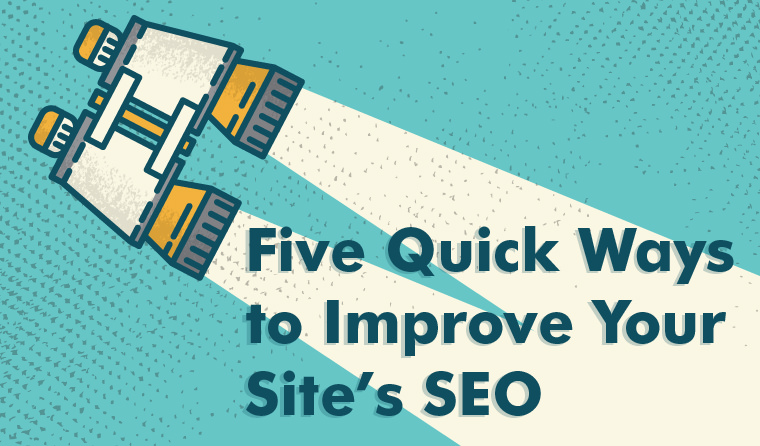Five Quick Ways to Improve Your Site’s SEO

If you’re a small business owner, you probably know that search engine optimization is important in helping your site succeed online. You probably also know that it can take a lot of time. When your day is filled with running your business, time can be short, and it can be difficult to focus a lot of energy on your website.
Never fear, though! There are some simple ways that you can help improve your site’s SEO, even if you don’t have a lot of time to dedicate to it. Keep these five tips in mind, and you’ll be on your way to an optimized site in little to no time at all!
Pay Attention to Your Page Titles
I’ve talked about page titles on our blog before, and they’re still incredibly important for SEO. Ideally, every page on your site will have its own unique title. If you have a content management system, it may do some of the heavy lifting for you on category or listing pages. For the most important pages of your site, though, you’ll want to write a customized title yourself. Remember to keep in mind what you want the page to be visible for (your keywords) and clickability. The page title should do two things: 1) It should show the searcher that your page will answer their question, and 2) It should encourage them to click on your site. For more information on what title tags are and some best practices to follow, check out my previous post on the subject.
Write Some Meta Descriptions
Okay, this one is a little tricky. Meta descriptions themselves are not a ranking factor, but they’re a great opportunity to make your site stand out in search results, which can, in turn, boost relevant organic traffic to your site. You should try to write custom meta descriptions for your most important pages. Remember to keep the length at 155 characters max, and try to include your keywords if possible. If the search engines display your description, the keywords will likely be bolded, increasing the chance that someone will click through to your site. Also keep in mind that you shouldn’t duplicate descriptions. If you don’t have time to write one, leave it blank!
Optimize Your Images with Alt Text
Optimizing images on your site is another easy way to improve your SEO. If you provide alt text for your images, you’ll increase the chances that they’ll show up in image searches. Keep this text short, sweet and use keywords only when it makes sense to. If your site has a content management system, you probably have the option to add alt text in a separate field when uploading images or possibly even after your images have been added, so it’s super easy!
Check Your Links
In order for your content to be found by search engines (and by visitors), you need to have links to it. Ideally, this will happen automatically when you add content to your site—it will either be linked from within the navigation or within a blog—but you should always check to make sure that it’s accessible after it’s published. On another note, making your site a resource will improve your SEO as well. If you’ve got related pages that you can point search engines and site visitors to, link to them within your new content. This will build your internal linking structure, making your content easier to access and improving your site’s authority and relevance with the search engines and your visitors.
Sign Up for Google Analytics and Google Search Console
If you don’t have data on your site, it’s impossible to know how it’s performing and what might need to be fixed, and we all know that site issues equal SEO issues. Google Analytics and Google Search Console (formerly Google Webmaster Tools) are free and easy ways to get your hands on some of this information. You might need some help from a developer to sign up—Google Analytics requires adding some code and, depending on the verification method you choose, Google Search Console may as well. Once you’re all set up, you can dive into the reports to monitor organic traffic and keep tabs on any issues that might arise, like broken links or hacking.
